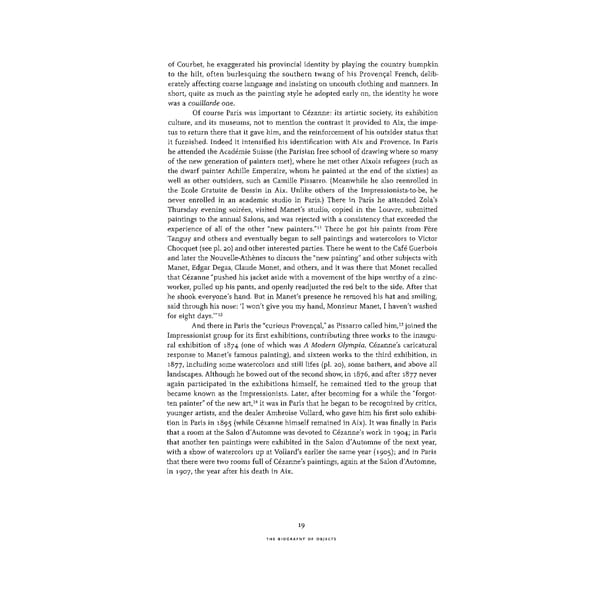of Courbet, he exaggerated his provincial identity by playing the country bumpkin to the hilt, often burlesquing the southern twang of his Provencal French, delib- erately affecting coarse language and insisting on uncouth clothing and manners. In short, quite as much as the painting style he adopted early on, the identity he wore was a couillarde one. Of course Paris was important to Cezanne: its artistic society, its exhibition culture, and its museums, not to mention the contrast it provided to Aix, the impe- tus to return there that it gave him, and the reinforcement of his outsider status that it furnished. Indeed it intensified his identification with Aix and Provence. In Paris he attended the Academic Suisse (the Parisian free school of drawing where so many of the new generation of painters met), where he met other Aixois refugees (such as the dwarf painter Achille Emperaire, whom he painted at the end of the sixties) as well as other outsiders, such as Camille Pissarro. (Meanwhile he also reenrolled in the Ecole Gratuite de Dessin in Aix. Unlike others of the Impressionists-to-be, he never enrolled in an academic studio in Paris.) There in Paris he attended Zola's Thursday evening soirees, visited Manet's studio, copied in the Louvre, submitted paintings to the annual Salons, and was rejected with a consistency that exceeded the experience of all of the other "new painters."11 There he got his paints from Pere Tanguy and others and eventually began to sell paintings and watercolors to Victor Chocquet (see pi. 20) and other interested parties. There he went to the Cafe Guerbois and later the Nouvelle-Athenes to discuss the "new painting" and other subjects with Manet, Edgar Degas, Claude Monet, and others, and it was there that Monet recalled that Cezanne "pushed his jacket aside with a movement of the hips worthy of a zinc- worker, pulled up his pants, and openly readjusted the red belt to the side. After that he shook everyone's hand. But in Manet's presence he removed his hat and smiling, said through his nose: 'I won't give you my hand, Monsieur Manet, I haven't washed 12 for eight days.'" 13 And there in Paris the "curious Provencal," as Pissarro called him, joined the Impressionist group for its first exhibitions, contributing three works to the inaugu- ral exhibition of 1874 (one of which was A Modern Olympia, Cezanne's caricatural response to Manet's famous painting), and sixteen works to the third exhibition, in 1877, including some watercolors and still lifes (pi. 20), some bathers, and above all landscapes. Although he bowed out of the second show, in 1876, and after 1877 never again participated in the exhibitions himself, he remained tied to the group that became known as the Impressionists. Later, after becoming for a while the "forgot- 14 ten painter" of the new art, it was in Paris that he began to be recognized by critics, younger artists, and the dealer Ambroise Vollard, who gave him his first solo exhibi- tion in Paris in 1895 (while Cezanne himself remained in Aix). It was finally in Paris that a room at the Salon d'Automne was devoted to Cezanne's work in 1904; in Paris that another ten paintings were exhibited in the Salon d'Automne of the next year, with a show of watercolors up at Vollard's earlier the same year (1905); and in Paris that there were two rooms full of Cezanne's paintings, again at the Salon d'Automne, in 1907, the year after his death in Aix. !9 THE BIOGRAPHY OF OBJECTS
 Cézanne in the Studio: Still Life in Watercolors Page 33 Page 35
Cézanne in the Studio: Still Life in Watercolors Page 33 Page 35